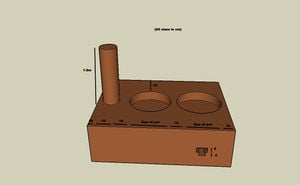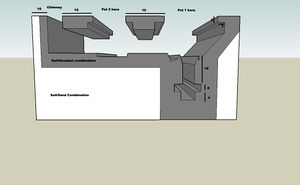
The rocket-lorena stove is a 2 pot rest stove and has an efficient conversion chamber which requires very little fuel. It has a firewood chamber and a chimney which further improves efficient burning. It can be made from locally available materials and so is affordable.
It is a great improvement over the normal three stone stove, that is common in villages, because of the vastly reduced fuel consumption, it simplicity to use and the short time it takes to cook food. The chimney mechanism reduces smoke and associated problems and it is firmly attached to the ground meaning there is less risk of injury occuring from spillages or accidents.
Its disadvantages are that it is less portable than the three stone stove and occupies a larger space. The rocket-lorena normally takes a number of hours and several people working to finish. That said once built, it is long lasting and durable (at least 10 years)
Materials and Requirements[edit | edit source]
- Clay or Anthill Soils - 4 wheelbarrows
- Sand, alternatively silt run off - 1 wheelbarrow
- Sawdust, alternatively rice husks, coffee husks, cotton seed husks, dried grass, dung - 1 wheelbarrow
- Bricks or large stones - approx 20
- Material for firewood shelf - thin metallic steel or fired clay slab
- Water - as appropriate for wetness of soil
- Wheelbarrow is useful for measurements
It is best to build during the dry season as the stove once build takes several weeks to dry and be ready for use. In the dry seasion this happens much quicker. The stove is best build as a community effort by getting a group to work together to gather and build the stove from the raw materials.
Preparing Materials[edit | edit source]
- Mix one wheelbarrow of anthill soil with one wheelbarrow of sawdust - add water gradually and knead the mixture as water is added - the mix is ready when it has a firm mortar like consistancy
- Mix two wheelbarrows of soil with one wheelbarrow of sand/silt - add water gradually and knead the mixture as water is added - the mix is ready when it has a firm mortar like consistancy
The reason that these two different mixtures are used is that the soil/sawdust mixture holds heat well and can hence improve the efficiency of the stove. The soil/sand mixture is less efficient and is hence used for the main structure of the stove
Construction[edit | edit source]
A plan of the stove is shown below for guidance (to follow). The exact dimensions depend on the size of pots that the villager has available. It is best to use what is available. This stove holds two pots, one needs to be smaller than the other
Foundations[edit | edit source]
- As the stove will be locate in a hut over a long period it is best to position the stove in a corner and on a reasonably flat setting
- First mark the area for the stove.
- Pour water on the foundation area
- Add a layer of soil/sand mixture and then lay 1 layer of bricks
- The bricks should be separated by approx 1cm, in between the bricks, fill with soil/sand mixture like building normal wall
Position the firewood chamber[edit | edit source]
- The firewood chamber need to be set now. This will be below the position of the first pot (see diagram). Measure this position, it will be approximately 15cm + half the diameter of the first (largest) pot
- Get two bricks and wrap each in plastic bags. Fix the first in position to form what will be the firewood chamber and the second to form what will be the conversion chamber
Building the main stove[edit | edit source]
- Build up the structure to the appropriate height using bricks and the mixtures as mortar
- Wherever heat is likely to be transferred use the soil/sawdust mixture rather than the soil/sand mixture. (e.g all around the firewood/conversion chamber bricks)
- Put the pots to be used in place and complete the stove, building around them.
- You will need to hollow though between the pots and then through to the chimney
- Build the chimney, it needs to be 1-2m high. This pull the heat through the combustion chamber to the second pot
Final Touches[edit | edit source]
- The firewood/combustion chamber can now be completed by removing the bricks to leave a hole for these chambers
- Fix the firewood shelf in position
- The stove needs to be left to dry for several weeks. If used prematurely it will crack and will not last so long
- After several weeks the stove will dry. The materials will naturally crack to some extent, any cracks can be filled in making more of the soil/sand mixture and filling
Photos & Diagrams[edit | edit source]
Diagrams


(big respect to google sketchup for making drawing 3d models free and simple)
Photos
The stove is the process of being built
Completed stove
Note Mar 31, 2023: the two above links are dead, the pictures aren't available anymore.
Uses[edit | edit source]
This above stove is used in several locations in Uganda.
It is the standard design used by the appropriate technology centre (ATC) in Mbale, East Uganda, and passed through to the rural villages within the region
Request for info[edit | edit source]
- Best resources?
These guys literally wrote the book on Lorena stoves and Rocket Stoves. Check out this sight for everything you ever needed to know about stoves and stove building. http://web.archive.org/web/20131027040242/http://www.aprovecho.org:80/web-content/media/media.html
- Indeed, this page is intended as a simple guide which can be noted and used practically. Maybe it can be padded out with some bits from the above site Cgfoz 16:04, 19 June 2007 (PDT)
Im not sure what makes this design either a rocket or a lorena stove. I dont see where the firewood goes into the stove in these designs. Am I missing something?).
- > Rocket - This refers to the efficient combustion of fuel (like in a rocket) The key components are the chimney, the dimensions, insulating inner materials and the sealed inner chambers
- > Lorena - This wikipedia page states that Lorena stoves originated from South America in the 70's. Their characteristics seem to be the practical design with chimney using appropriate materials. I can't find any info on who or what Lorena is. Anecdotally, it's said that the name is a portmanteau of the Spanish words lodo (mud) and arena (sand).
- > Rocket- Lorena - The above wikipedia article suggests that Lorena stoves were originally inefficient. However when I saw the recent R-L-stove in action it was extremely efficient. From what I remember hearing, the hybrid stove takes the practicality/appropriateness/stability of the Lorena stove and adds the efficiency of Rocket stove
- The orignal Lorena stove was inefficient in the fact that the *material* it was made out of was extremely dense, and therefore a great thermal battery. The fire burned extremely efficiently, but most of the energy (or enough of it) went into heating up the dense material that the stove was made out of. The primary inefficiency of 3 stone fires is not in the combustion (which still ends up being about 90% efficient), but in the heat transfer from the fire to the actual pot, which is anywhere from 10% to 40% efficient. More info here: Principles for Wood Burning Cookstoves.pdf
- > Where does firewood go? - Rocket-Lorena is extremely efficient and does not need a large area for firewood like a 3-stone fire (you can boil water using 2-3 sticks). If you look at the first diagram, you light up the end of some sticks and then place them in the hole in the side. As they burn you push them in. Here is a ofelia sho.cfm photo of a lorena stove which should give you a better idea - Cgfoz 16:04, 19 June 2007 (PDT)
- Who is Lorena? --Chriswaterguy · talk 21:27, 18 March 2007 (PDT)